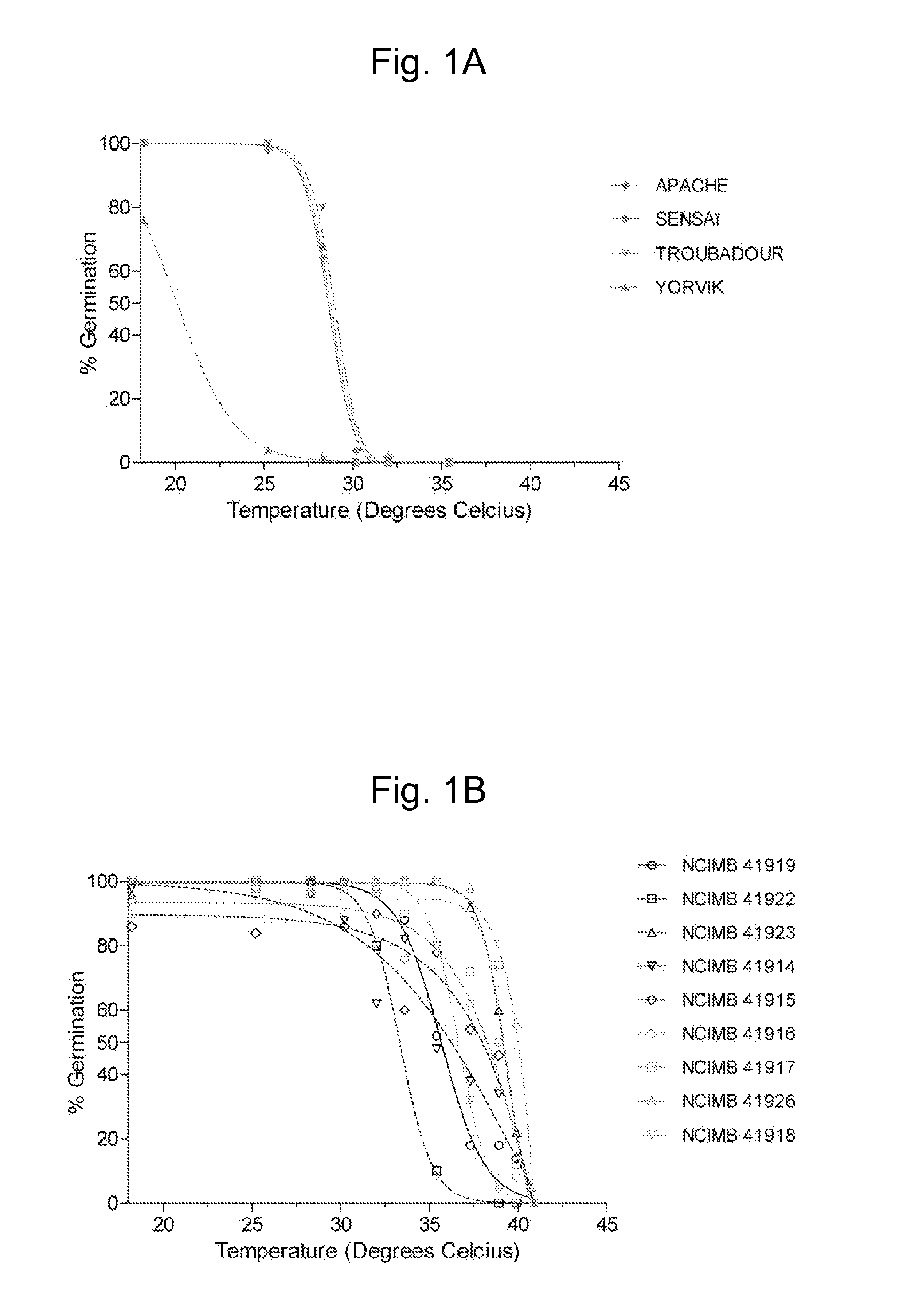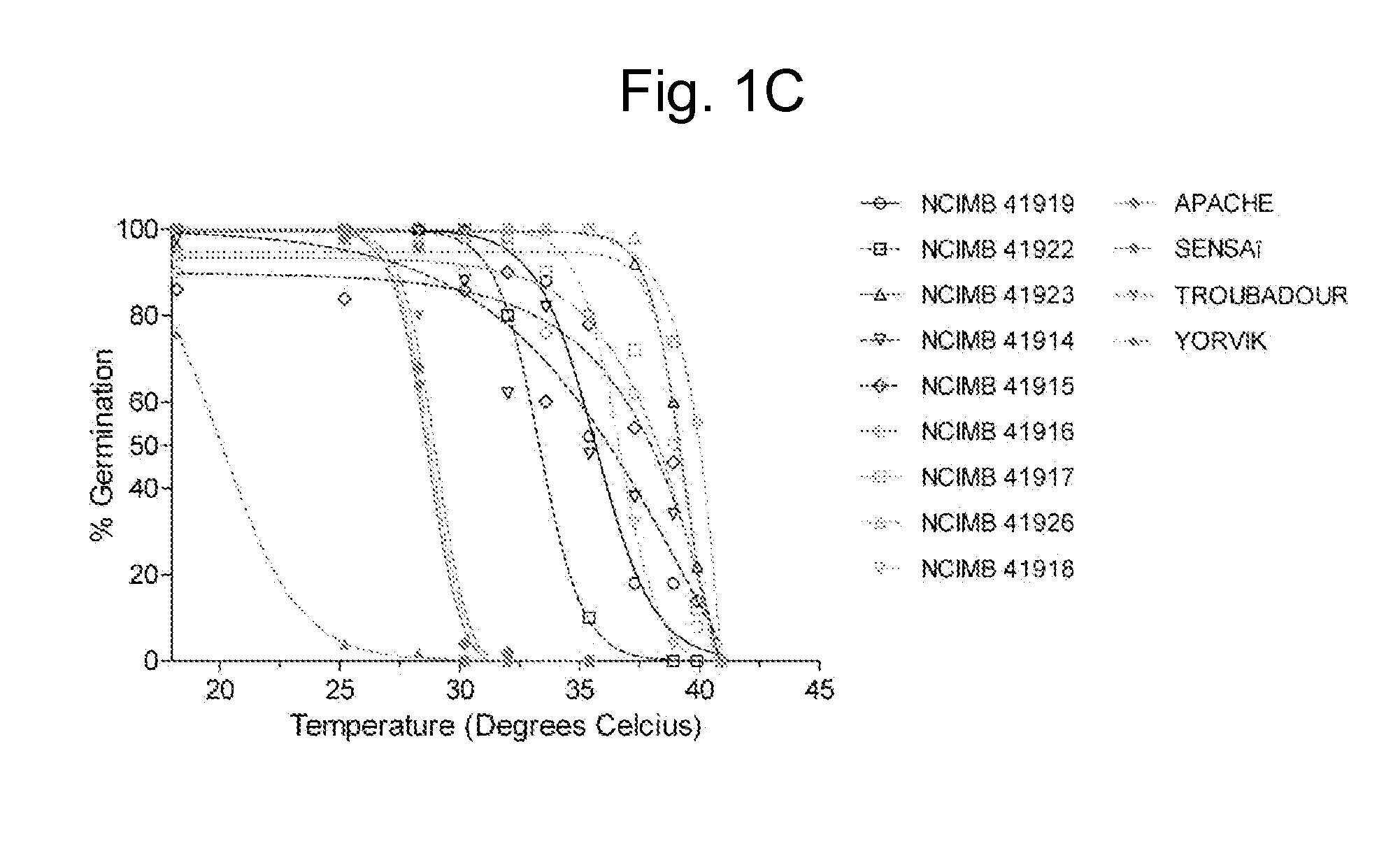High temperature germinating lettuce seeds
a technology of lettuce seeds and high temperature, applied in the field of lettuce seeds (lactuca sativa l.) plants, can solve the problems of modern lettuce cultivars, high labor and equipment requirements, and dormancy, and achieve the effects of improving the ability to germinate, reducing or eliminating the need for costly priming treatments, and increasing the total acreag
- Summary
- Abstract
- Description
- Claims
- Application Information
AI Technical Summary
Benefits of technology
Problems solved by technology
Method used
Image
Examples
example 1
Genetic Modification of Lettuce Seeds by Ethyl Methane Sulfonate (EMS)
[0120]Seeds of the wild type lettuce varieties Apache, Sensaï Troubadour, and Yorvik (all four from Rijk Zwaan, De Lier, The Netherlands) were treated with EMS by submergence of approximately 2000 seeds per variety into an aerated solution of either 0.5% (w / v) or 0.7% EMS for 24 hours at room temperature.
[0121]Approximately 1500 treated seeds per variety per EMS dose were germinated and the resulting plants were grown in a greenhouse in The Netherlands from May to September to produce seeds.
[0122]Following maturation, M2 seeds were harvested and bulked in one pool per variety per treatment. The resulting eight pools of M2 seeds were used as starting material to identify the individual M2 seeds containing high temperature germination alleles.
[0123]The efficacy of the genetic modification procedure was assessed by determining the occurrence of bleached plants, which is indicative for chlorophyll loss due to modifica...
example 2
Identification of Lettuce Seeds Capable of Germinating at a High Temperature
[0124]Lettuce seeds capable of germinating at a high temperature were identified amongst the M2 seeds that were produced as a result of the EMS treatment described in Example 1.
[0125]Of each of the 8 available M2 pools, approximately 2000 seeds were germinated on wetted filter paper in a closed container. The M2 seeds of Apache, Yorvik and Troubadour were incubated at 34° C., whilst the M2 seeds of Sensaï were incubated at 32° C., under continuous dark conditions (24 h / day) in order to mimic natural germination conditions beneath the soil or when seeds are encapsulated in pellets.
[0126]Any seeds that germinated at the given temperatures were grown into plants. These plants were self-fertilized to produce M3 seed. The M3 seeds were again germinated at 34° C. under continuous dark conditions, to confirm the presence of high temperature germination alleles.
[0127]The confirmed M3 seeds were grown into M3-lines w...
example 3a
Seed Germination Testing
[0128]Germination tests were performed at different temperatures, to determine the cumulative germination over time at a given temperature for each seed lot of wild type lettuce varieties Apache, Sensaï, Troubadour, and Yorvik, as well as the EMS treated seeds of the deposit (obtained in Example 2).
[0129]For each seed lot, 100 seeds were sown on top of round filter paper, which was wetted with tap water. The seeds sown on the round filter paper were in turn placed inside a non-transparent plastic tray, which itself was lined with a large square piece of beet filter paper wetted with tap water. Additionally, a temperature recording device was placed on the beet filter paper to record the actual germination temperature at seed level. The tray was then closed with a well-fitted non-transparent lid, and wrapped inside a layer of dark plastic. The trays were placed inside a pre-heated incubator at the desired temperature. The germination tests were conducted from ...
PUM
 Login to View More
Login to View More Abstract
Description
Claims
Application Information
 Login to View More
Login to View More - R&D
- Intellectual Property
- Life Sciences
- Materials
- Tech Scout
- Unparalleled Data Quality
- Higher Quality Content
- 60% Fewer Hallucinations
Browse by: Latest US Patents, China's latest patents, Technical Efficacy Thesaurus, Application Domain, Technology Topic, Popular Technical Reports.
© 2025 PatSnap. All rights reserved.Legal|Privacy policy|Modern Slavery Act Transparency Statement|Sitemap|About US| Contact US: help@patsnap.com


